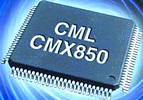Highly versatile communications controller
19 May 2004
Telecoms, Datacoms, Wireless, IoT
News & Events

The trend throughout the telecoms industry is to integrate more product functions onto fewer chips, with single-chip products being the ultimate target in many applications. The CMX850 from CML brings together the very low power modem technology developed for the CMX860/867/868 range with an enhanced version of the widely used 80C51 microcontroller. The result is a highly versatile, low power, communications controller.
The interfacing to external memory (ROM/Flash and SRAM), LCD controller, and keypad is very straightforward and removes the need for 'glue' logic in many applications. All of the standard 80C51 features are retained and access to enhancements occurs through special function registers (SFRs). The development of software, therefore, requires only a standard compiler and PROM emulator.
The on-chip modem is essentially the two port circuitry (line and phone) of the company's CMX860 but enhanced to V.22bis (2400/2400). Communication between modem and 80C51 takes place through a C-Bus emulation which is mapped into the 80C51's special function register area. Users of the CMX860/7/8 will recognise the format and have no difficulty in moving current software onto the 80C51 platform.
The company says much attention has been paid in the design of the CMX850 to reduce power consumption to an absolute minimum. Numerous powerdown options allow functional elements not currently in use to be turned off. The 80C51 main clock can be selected to run from 12 MHz down to 12 kHz, with external memory accesses shortened to conserve power as main clock speed is reduced.
Versatility has also been maximised by the introduction of seven additional sources of interrupt built around the new 80C51 functions. With the ability to wake the microcontroller from various powerdown states, these interrupts open up whole new regimes of power conservation.
The CMX850 is targeted at low power, battery operated terminals which need to access the PSTN to upload or download data. Examples are: SMS and ADSI terminals; telemetry and meter reading systems; security systems; feature phones; routers; EPOS terminals; e-mail and Internet appliances.
Further reading:
What does Wi-Fi 7 mean for South African networks?
Telecoms, Datacoms, Wireless, IoT
With Wi-Fi 7 (802.11be), we are finally looking at a standard that was built, not just for more devices, but for the new way networks are used.
Read more...
Multiprotocol wireless SoC
RF Design
Telecoms, Datacoms, Wireless, IoT
The nRF54LM20A from Nordic Semiconductor is a multiprotocol wireless System-on-Chip designed for demanding designs in Bluetooth devices.
Read more...
High performance communication
iCorp Technologies
Telecoms, Datacoms, Wireless, IoT
Quectel’s FCS950R is a high-performance Wi-Fi 5 and Bluetooth 4.2 module that can deliver a maximum data rate up to 433,3 Mbps in 802.11ac mode.
Read more...
Expanded STM32WL3x line for IoT sensors
Altron Arrow
Telecoms, Datacoms, Wireless, IoT
The STM32WL31x and STM32WL30x are more tailored versions of the STM32WL33x for designers who wish to focus on specific features, while lowering their bill of materials.
Read more...
Full-band GNSS helical antenna
RF Design
Telecoms, Datacoms, Wireless, IoT
A key feature of Calian’s HC3990XF antenna design is that it does not require a ground plane, making it ideal for size-constrained applications.
Read more...
BLE and BT Mesh module
iCorp Technologies
Telecoms, Datacoms, Wireless, IoT
The HM-BT4531 from HOPERF is a BLE data transmission module that features an ARM Cortex-M0 32-bit processor.
Read more...
Espressif entering the Wi-Fi 6E market
iCorp Technologies
Telecoms, Datacoms, Wireless, IoT
Espressif Systems is entering the Wi-Fi 6E market, extending its connectivity portfolio into the domain of high-throughput, low-latency wireless solutions.
Read more...
Ultra-low jitter clock buffers
Altron Arrow
Telecoms, Datacoms, Wireless, IoT
New SKY53510/80/40 family of clock fanout buffers from Skyworks are purpose-built for data centres, wireless networks, and PCIe Gen 7 applications.
Read more...
Cutting-edge broadband power amplifier
RFiber Solutions
Telecoms, Datacoms, Wireless, IoT
Designed for high efficiency and reliability, the WPGM0206012M from WAVEPIA is a cutting-edge broadband GaN MMIC power amplifier operating from 500 MHz to 8,5 GHz.
Read more...
Workflow and asset management solutions
Asset Management News & Events
Zamatrack’s innovative workflow and asset management solutions feature the Worxit platform. This all-in-one solution allows businesses to streamline operations with real-time tracking, GPS data, and custom reports.
Read more...


